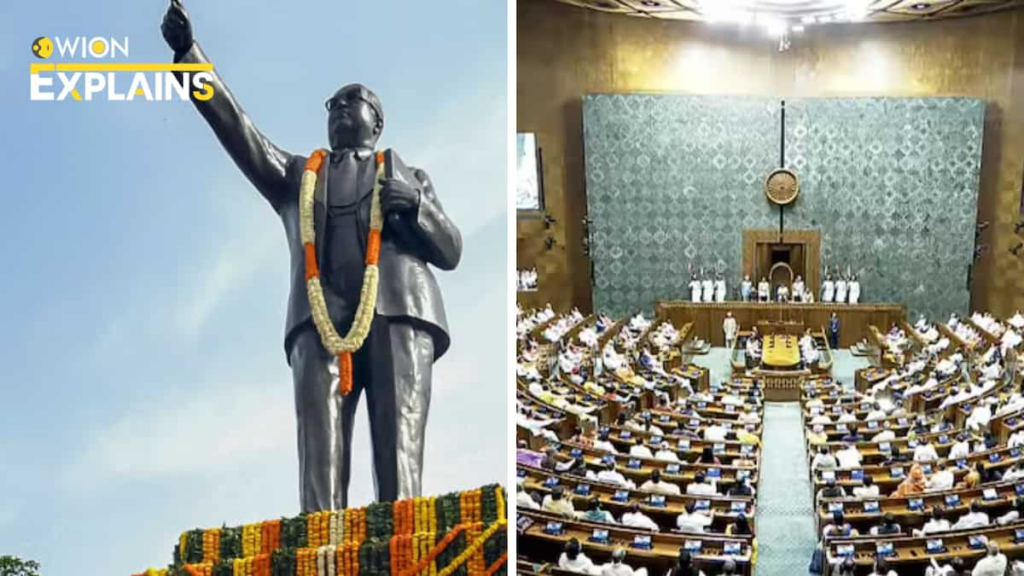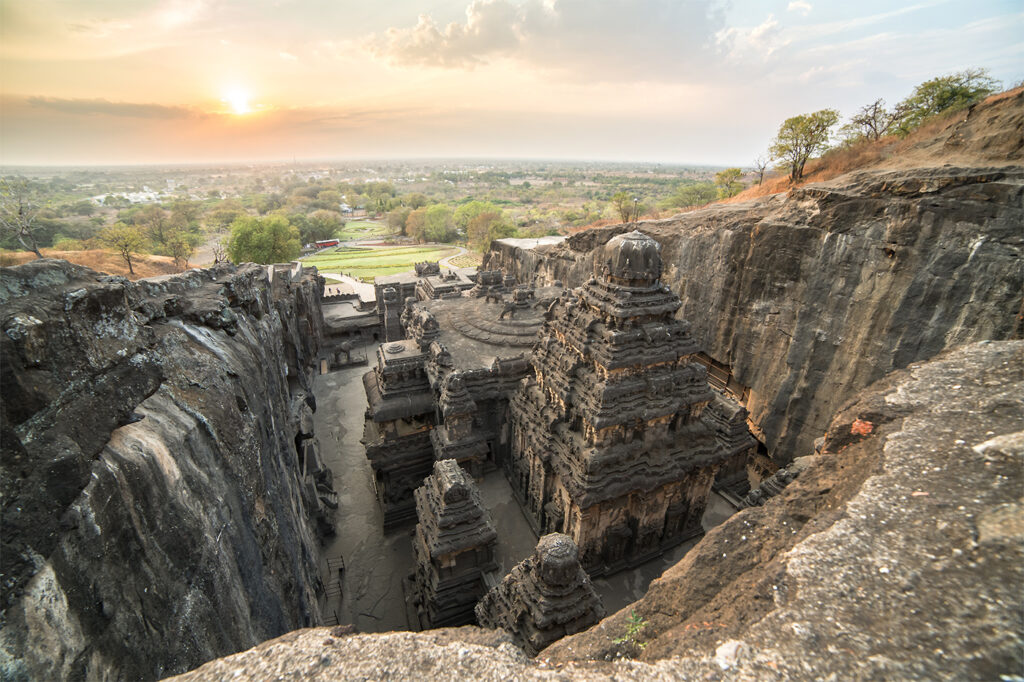
Explained: What is the ‘Ambedkar row’ that disrupted Indian Parliament?
From verbal duels to physical duels, Indian Parliament has seen it all this week, as a result of the now infamous ‘Ambedkar Row’. After the embarrassing ruckus that took place on Thursday, the ruling BJP has filed a Police complaint against Leader of the Opposition Rahul Gandhi for “physical assault and incitement”.
In response, the Opposition Congress party has filed a Police complaint against BJP MPs for pushing Congress chief Mallikarjun Kharge and “physically manhandling” Rahul Gandhi. On Friday, the Lower House of Parliament Lok Sabha and the Upper House Rajya Sabha have been adjourned sine die(without any future date specified for resumption).
How it all began…
The political slugfest erupted after Home Minister Amit Shah’s statement on BR Ambedkar in the Rajya Sabha during a debate on the ’75th year of the adoption of the Indian Constitution’. Taking a dig at the Congress-led opposition, Amit Shah mentioned that, “it has become a trend to repeat Ambedkar’s name over and over. If they had chanted God’s name as much, they would have attained heaven in seven lifetimes”(remarks originally made in Hindi). Shah expressed happiness that more people were taking Ambedkar’s name these days but also went on to list out what he cited as injustices meted out by the Congress Party. Shah also reminded everyone that Ambedkar had to quit the first cabinet led by Jawaharlal Nehru, due to his disagreement with the Congress government’s policies.
Opposition Parliamentarians considered Shah’s remarks as an insult to Ambedkar and started their protests and social media offensive. Rahul Gandhi said, “Those who believe in Manusmriti will definitely have problems with Ambedkar ji.” The Congress party alleged that Shah’s remarks during a debate on the Constitution show that the BJP and the RSS leaders have a “lot of hatred” for Ambedkar.
Shah accused the Congress of sharing a trimmed version of his speech. As the controversy escalated, Congress MPs began demanding the resignation of the Home Minister for allegedly insulting Ambedkar. Prime Minister Modi came to the defence of Amit Shah, and accused the Congress of “theatrics”.
The scuffle in Parliament
On Thursday, the ruling BJP-led NDA and opposition INDIA bloc representatives had staged a protest in the Parliament premises, when a scuffle broke out between the two sides. Two BJP MPs Pratap Chandra Sarangi and Mukesh Rajput were injured and later hospitalised.
BJP MP Pratap Chandra Sarangi has alleged that he was hurt after getting a push from Congress leader Rahul Gandhi. Sarangi claimed that he was standing on the stairs when another member of Parliament fell on him, leading to an injury on his head. Further, a woman BJP MP accused Rahul Gandhi of “misbehaving” with her. BJP’s Phangnon Konyak alleged that Rahul Gandhi shouted at her when she was protesting at the Parliament premises.
“Today while protesting, it was a peaceful protest. I was standing outside just below the staircase of Makar Dwar. Something happened to me for which I feel really disheartened. Leader of Opposition of Lok Sabha Shri Rahul Gandhi ji came in very close proximity to me. I really felt very uncomfortable and he started shouting at me which I felt is very unbecoming of a leader of the opposition,” Konyak said. The BJP MP from Nagaland said that she could have defended herself but did not do so.
Congress ally DMK’s Tiruchi Siva contested the claims made by the ruling party MPs. “This is the version of one side. There was a demonstration going on outside and Mr Rahul Gandhi, the Leader of the Opposition in the other house, is a very senior person and he has complained that he was only pushed. We respect all elder members. We respect every woman in this country. Nothing has happened of that sort,” he said.
The legacy of Dr BR Ambedkar
Ambedkar’s legacy as a socio-political reformer continues to have a significant effect on modern India, so much so that Ambedkar is equated to God by his followers. He holds a social and political influence on Indian society, thanks to the social justice movement which empowered backward and suppressed classes in the country. His political philosophy has given rise to a large number of political parties, publications and workers’ unions that remain active across India.
Dr Bhimrao Ramji Ambedkar (1891-1956) was born on 14 April 1891 in Mhow Cantonment, Madhya Pradesh. He completed his primary schooling in Satara, Maharashtra and completed his secondary education from Elphinstone High School in Bombay. His education was achieved in the face of significant discrimination, for he belonged to the Scheduled Caste (then considered as ‘untouchables’). In his autobiographical note ‘Waiting for a Visa’, he recalled how he was not allowed to drink water from the common water tap at his school.
Also watch | Race to Power: Uproar in Indian Parliament over Amit Shah’s remarks on Ambedkar
Dr Ambedkar graduated from Bombay University in 1912 with a BA in Economics and Political Science. On account of his excellent performance at college, in 1913 he was awarded a scholarship by Sayajirao Gaikwad, then Maharaja (King) of Baroda state to pursue his MA and PhD at Columbia University in New York, USA. After Columbia, Dr. Ambedkar moved to London, where he registered at the London School of Economics and Political Science (LSE) to study economics, and enrolled in Grey’s Inn to study law. However, due to lack of funds, he had to return to India in 1917. In 1918, he became a Professor of Political Economy at Sydenham College, Mumbai (erstwhile Bombay).
Dr Ambedkar founded Bahishkrit Hitkarini Sabha (Society for Welfare of the Ostracized) and led social movements such as Mahad Satyagraha in 1927 to demand justice and equal access to public resources for the historically oppressed castes of the Indian society. In the same year, he entered the Bombay Legislative Council as a nominated member.
In 1946, he was elected to the Constituent Assembly of India. On 15 August 1947, he took oath as the first Law Minister of independent India. Subsequently, he was elected Chairperson of the Drafting Committee of the Constituent Assembly and steered the process of drafting India’s Constitution. Mahavir Tyagi, a member of the Constituent Assembly, described Dr Ambedkar as “the main artist” who “laid aside his brush and unveiled the picture for the public to see and comment upon”.
Dr Rajendra Prasad, who presided over the Constituent Assembly and later became the first President of the Indian Republic, said: “Sitting in the Chair and watching the proceedings from day to day, I have realised as nobody else could have, with what zeal and devotion the members of the Drafting Committee and especially its Chairman, Dr Ambedkar in spite of his indifferent health, have worked. We could never make a decision which was or could be ever so right as when we put him on the Drafting Committee and made him its Chairman. He has not only justified his selection but has added lustre to the work which he has done.”
After the first General Election in 1952, he became a member of the Rajya Sabha. He was also awarded an honorary doctorate from Columbia University in the same year. In 1953, he was also awarded another honorary doctorate from Osmania University, Hyderabad.





Responses